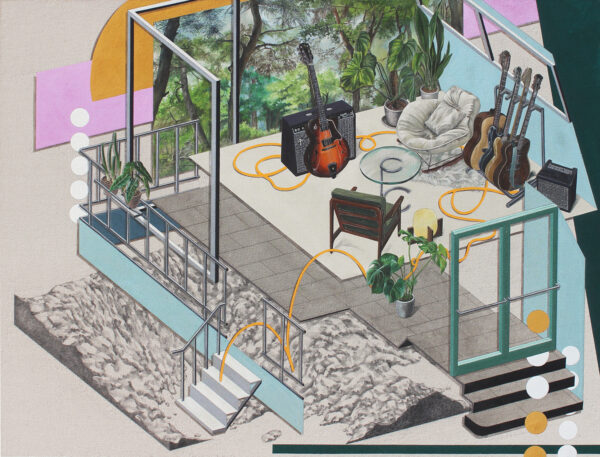No Way Back
2024. 8. 30 - 11. 16 | [GALLERIES] Lechbinska Gallery
Luo Mingjun

Installation View of ‘No Way Back’ at Lechbinska Gallery
The series of works dedicated to water develops quite naturally from two earlier ones, the Cloud series and the Magnolia series. However, the theme of liquid (especially ink) runs through Luo Mingjun’s entire oeuvre. What connects the three series is, on the one hand, the highly diluted use of white oil paint on a gray raw canvas and, on the other, the autobiographical projection via these themes. All of these paintings are self-portraits.

Installation View of ‘No Way Back’ at Lechbinska Gallery
The magnolia traditionally evokes spring. Originally from Asia, the plant grows in Luo Mingjun’s garden just outside her studio window in Biel and unfurls its magnificent blossoms for a few short weeks. For the artist, it simultaneously becomes a symbol of her Swiss-Chinese dual identity and rootedness, but in a sign of transience.
The cloud is also reminiscent of the ephemeral. It can appear and disappear within minutes. Luo Mingjun materializes fluidly on the canvas and – in contrast to Chinese tradition, which uses it as a link between earth and water (shan-shui) – turns it into an independent object, a figure, a portrait… of something intangible.

Installation View of ‘No Way Back’ at Lechbinska Gallery
The recently created “aquatic” series also isolates a theme but unfolds it in a variety of forms. The entire spectrum between still water and explosive splashes can be found here. The ocean connects or separates the continents, so it is also a space between the West and Asia, one of those “third places” that are close to the artist’s heart. Luo Mingjun does not depict the sea in its robust materiality, as Gustave Courbet, for example, does in his depictions of waves; for her, the sea is a reflective surface, whether during low tide with still, calm water that reflects the sky, or as a stormy sea, as a foamy tangle, with light effects that shine through dematerializing water. Two other works demonstrate the glittering surface of the sea with pastel chalks, a technique that Luo Mingjun rarely uses and which enables a shimmering, paradoxically more immaterial rendering than the more fluid oil painting. In short, for her, the sea is never substance or presence, but effect, and appearance. In universal symbolism, water is the most feminine of the four elements. Describing herself not only as a woman but also as a hybrid being (from here and there) through water testifies to a multifaceted, never-completed self-discovery.
In 2016, I wrote: “Luo Mingjun’s entire oeuvre is about transition, about the exchange between light (which is sometimes just a flicker) and shadow, emptiness and fullness, order and chaos, appearance and disappearance, precision and evanescence.” Looking today at the latest works exhibited in Zurich, I would add: “calm and wildness, rhythm and monotony”, as if the revelation of the different states of water would contribute to sharpening differences and contrasts, thus wonderfully expanding the field of expressive possibilities – depending on the artist’s state of mind.
Text by Bernard Fibicher
Lechbinska Gallery
Muehlebachstrasse 12, 8008 Zurich
+41 43 243 71 06
[GALLERIES] Lechbinska Gallery
- Dates
- 2024. 8. 30 - 11. 16











